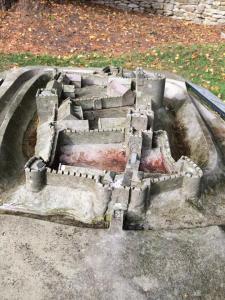My previous Travel Tales blog talked about the Forest of Bowland and Skipton. Today, we’re going to two places that sometimes get forgotten by the traveler who is interested in visiting places having some Richard III connections: Rievaulx Abbey and Helmsley Castle.
From our temporary homebase in Ripon-Masham, we drove 30 miles to visit one of the gems of English medieval history. Like Fountains and Byland Abbeys, Rievaulx was one of the great Cistercian monasteries of medieval Europe, and its ruins are said to be the “most complete” of any of the dissolved religious houses in England. It has one of the most spectacular natural settings within a deep valley in the North York Moors National Park; however, to take a photograph from the best vantage point one has to pay an admission price of over Ł5.00 per person to the National Trust’s Rievaulx Terrace. (It was raining and it didn’t seem worth the price of admission just to take a photograph.)
At the height of its popularity, as many as 650 men – monks and lay brothers – prayed, sung masses, lived and worked within a completely self-sufficient community. But it also provided hospitality and lodgings to kings and great noblemen. In 1322, Edward II was visiting Rievaulx when his army was surprised by the Scots on nearby Shaws Moor and defeated by them at the battle of Byland. Other than that, the abbey seems to have been cut off from the rest of the world, suffered significant losses during the Black Death, but made something of a come back during the 15th century when records show the monks renting out pastureland to 49 tenant farmers. Visiting ruins of such grand buildings is always awe-inspiring – albeit a little melancholy.
The next stop was to Helmsley Castle, only three miles to the east from Rievaulx. I’d never heard of this particular castle in all my “Ricardian” reading, but Edward IV granted it to Richard following the execution of George, Duke of Clarence, in 1478. Helmsley became a great castle when Robert de Roos II (c. 1186-1227) set about rebuilding the pre-existing fortress structure. De Roos, also known as “Fursan”, was one of the 25 barons chosen to ensure King John’s compliance with Magna Carta, and this was highlighted in an exhibit at its visitors’ center.
The castle remained in the continuous possession of the de Roos lords until the Battle of Hexham in 1464, when its current owner was executed and attainted for fighting on behalf of the deposed Henry VI. The castle’s east tower dominates the nearby town of Helmsley and the surrounding parkland where medieval lords would have enjoyed hunting and other recreational activities. Although Richard possessed this castle from 1478-1485, there is no record of him residing here. However, he might have dropped by for a visit when he was at Rievaulx Abbey on May 20-21, 1484 according to Rhoda Edwards’ “The Itinerary of King Richard III”. Indeed, as Richard next traveled from Rievaulx Abbey to Scarborough, it would be almost impossible for him not to pass by his castle at Helmsley – it is literally on the eastward route over the Moorlands towards Scarborough. Who knows, perhaps he indulged in a bit of hawking in the lovely country that surrounds the castle. Or maybe he took a brief meal there before setting out to his next destination. Imagine that: Richard’s banner might have hung over Helmsley Castle for a short time!
Why was Richard III traveling to Rievaulx and passing by Helmsley to his beloved Scarborough? Well, he was continuing what he called “Our Great Journey” or what we now call Royal Progress, following his coronation in July of 1483 and interrupted by Buckingham’s rebellion in October of 1483. It consumed most of his brief 26-month reign, and totaled an astounding 2,750 miles. Other English kings were equally active in traveling through their realm, especially during politically stressful periods and after their coronations. As Rhoda Edwards shows, both Edward IV and Henry VII did the same. It wasn’t just for pleasure. The King brought his household, and perhaps more importantly, a council of administrators who would draw up charters, continue royal business, and receive and hear petitions from the people. Given the fact that Richard III’s royal retinue numbered in the range of 200 persons, it would seem likely that Rievaulx Abbey and Helmsley Castle provided lodgings for these royal servants. So, this was not just a time for Richard III to bask in the glow of his recent crowning, but was intended to create connections to his subjects and to introduce them to the overall style and “tenor” of his rule.
Here are some more photos from our outing to Rievaulx and Helmsley:




